The most recent post on the excellent British website ThinkinGardens is about the use of allusions in gardens. Noel Kingsbury, one of three people taking part in the conversation, suggested that allusions were all well and good in gardens from other times and places but that in today’s gardens, they are outmoded.
“Allusion in the West which previous generations of artists and garden makers used was based on Classical and Christian mythologies. Very few of [us] are now conversant with either. So – first question – how do we create and use a contemporary language of allusion?
And the very practical question two – how do you ‘get the message across’? Either allusion works or it doesn’t.”
In effect, Kingsbury is saying that allusions to classical sources are elitist, that you either ‘get’ the allusion or you don’t based on your familiarity with classic mythology, the Bible or Shakespeare, to note three of the most common sources of literary allusions in English.
I disagree. For large numbers of people many allusions based on classical and Biblical sources are as ‘readable’ now as they were in the past. In fact some are so obvious that they have become clichés to be avoided.
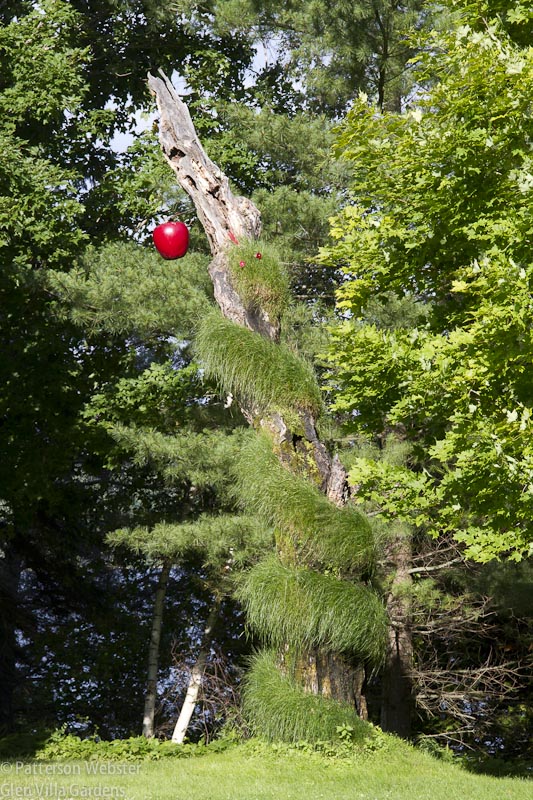
The grass snake at Glen Villa is an obvious Biblical reference to the Garden of Eden. Winding its way up the tree, the snake also suggests paintings by Lucas Cranach and others. Using reflectors for the snake’s eyes gives the allusion a contemporary twist and adds a touch of humour.
Snakes in gardens, for instance. The idea is widely understood and when used in a garden could be heavy-handed. But at the same time it suggests something that every gardener believes, that while their gardens may be wonderful, they remain imperfect, a suggestion rather than a realization of paradise.
At the Villa d’Este at Tivoli, statues of Hercules dating from the 1500s linked Cardinal d’Este and his family with the strength and power of the demigod. Garden visitors of the period would ‘get’ that message because they knew that the d’Este family claimed to be descended from Hercules, but even without that specific knowledge, the layout of the garden and the arduous climb to the palazzo at the top of the hill made the point clear.
A statue of Hercules sends a similar message today. Whether at Villa d’Este in Italy or at Vaux-le-Vicomte in France or at Kykuit in New York State, the presence of Hercules tells us something about the person who built and owns the garden — she or he is large and powerful; approach with care.

This statue of Hercules dominating his surroundings is at the entrance to Kykuit, the country house of the Rockefeller family. Allusions to power and dominance, even over the landscape itself, are obvious.
Kingsbury asks how we can create and use a contemporary language of allusion. My response is that many garden designers, landscape architects and artists are doing this already, using today’s cultural landscape to allude to larger and broader concerns.
Andy Goldsworthy, for example. Permanence and impermanence, constant themes in gardens throughout the centuries, are central allusions in his works whether they are made from stone, leaves, snow or the petals of flowers. For a thoughtful viewer, the ephemeral nature of much of what he does highlights current concerns about the environment and our effect on it.
Allusions to scientific discoveries and mathematical ideas feature in the works of Charles Jencks; these allusions stretch our minds beyond the confines of the particular garden, which is what allusions are meant to do.

A Fibonacci sequence appears on the inside of this metal structure at the top of the Universe Cascade in the Garden of Cosmic Speculation.
More mundane allusions exist as well. In my village in rural Quebec, a tree stump by the road is painted with the picture of a woman with blue hair piled high. Could anyone who watches tv miss the allusion to the Simpsons or doubt that someone named Marge lived there?
A more literary allusion appears at a junction in the woods at Glen Villa where a sign on a tree trunk painted yellow announces that a choice must be made. Most people passing by will recognize the source — Frost’s poem is so overworked that you can easily imagine it appearing on a poster on the ceiling of a dentist’s office. But seeing the sign, the walker may think again about the poem and about what it means. They may read it again. They may even understand that it doesn’t matter which path they take — both lead to the same destination.

The dentist’s poster would almost certainly show an autumn scene with footprints receding along the less travelled path. No matter that the poem suggests something different.
Allusions aren’t necessarily elitist or exclusionary although they can be. Much depends on what the viewer brings to the garden and to the effort she is willing to expend. Seeing something unfamiliar, does she simply pass by or does she stop to look, to think, to question?
Many people visiting the English garden Rousham will wonder why a statue of a lion attacking a horse appears at the end of the bowling green in front of the house. Did General Dormer, the garden’s owner, choose the statues for his garden or was it the designer, William Kent? Is there a connection between Dormer and a dying gladiator, or between him and the attacking lion? Or were they simply the statues that happened to be available when Dormer or Kent went shopping?
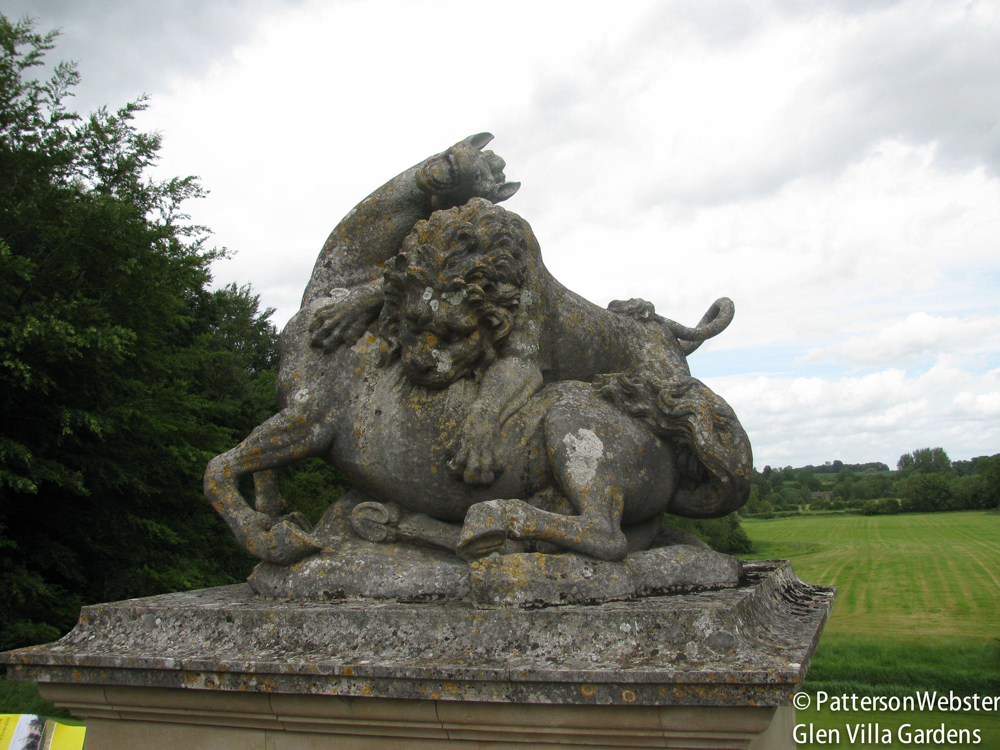
The statue of a lion attacking a horse is particularly savage. Set against a backdrop of verdant fields, it creates a note of tension and suggests a violent confrontation between peace and war. The notion of opposition and duality continues throughout the garden.
A visitor to the contemporary Italian garden, Bosco della Ragnaia, may feel a sense of disappointment at not seeing lots of flowers. Or she may look at the arrangement of trimmed shrubs and blocks of tufa and wonder why it feels familiar. Is Sheppard Craig, the garden’s creator, alluding to something in the history of Italian gardens? And what about the name of the garden? Or the multiple references to opposing qualities — night and day, light and dark. Why does Craig picture himself as Pan and who is represented in the small statues of goddesses that appear throughout?
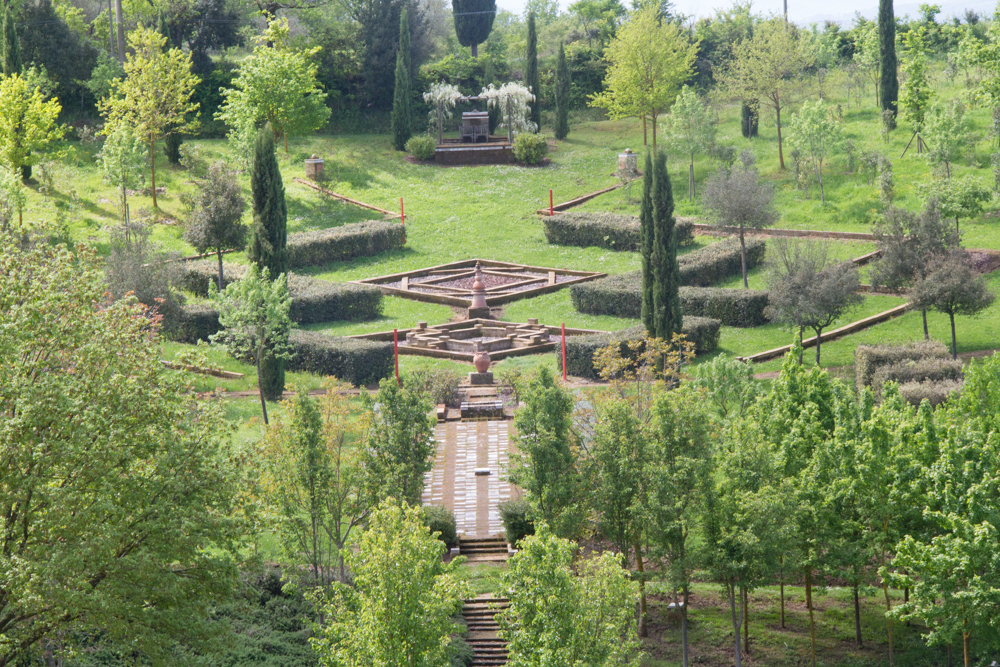
In order to enjoy this garden, you don’t need to know that its name refers to the Renaissance practice of capturing songbirds. Once you know, however, you may ask yourself what the garden is capturing now. Is it your mind?
Allusion is one of many tools in a garden designer’s toolkit, as useful today as it was in the past. Ian Hamilton Finlay’s garden Little Sparta, considered one of the 20th century’s greatest, is jam packed with allusions. Many will escape most viewers unless they bring a knowledge of the classics with them or make a concerted effort to understand the allusions once they’ve left. Since many allusion refer to war and warships, understanding them may require a knowledge of history which certainly can vary with the age of the viewer. How many teens, for instance, will recognize the humour of the sign pointing to the Siegfried Line that sends them marching to the site below?
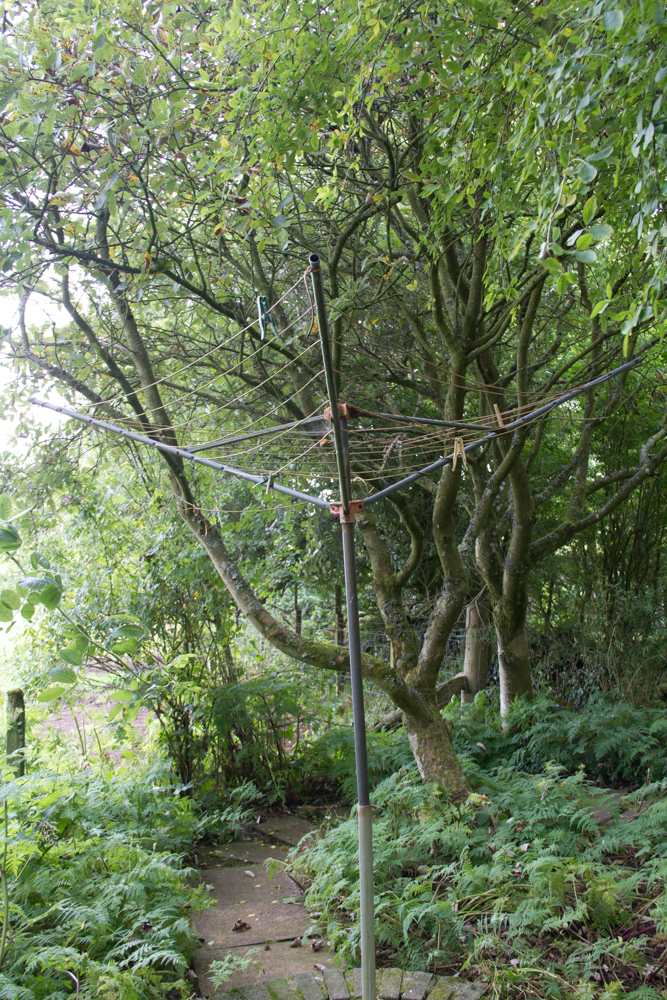
Do you think Finlay hung out his washing here?
At Glen Villa, a wooden bridge that joins our property to our neighbour’s becomes a visual reference to a linguistic metaphor — the idea of bridging gaps between people and countries and ideas. The signs are a playful allusion — appropriately so, since the word allusion comes from the Latin alludere, to jest or play with. The signs play with the idea of the metaphoric versus the concrete; the sign says that the bridge is not, and yet clearly it is. The signs allude less directly to René Magriette’s painting, The Treachery of Images, where a picture of a pipe is accompanied by the words, Ceci n’est pas une pipe. They may also say something about our relations with our neighbour.
Does it matter if the person crossing the bridge ‘gets’ these allusions or is the touch of humour enough in itself?
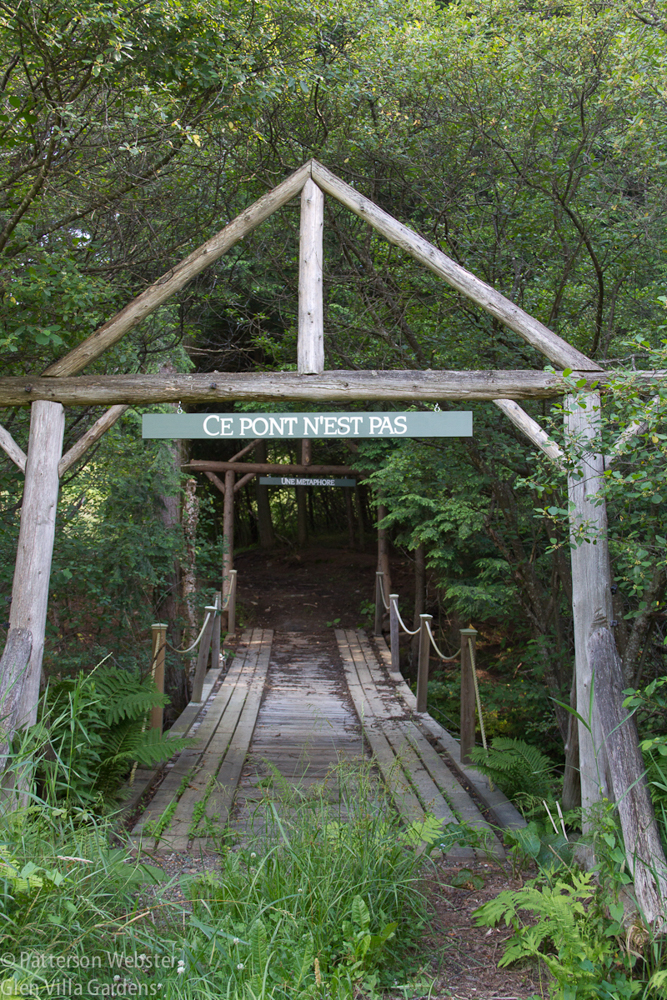
The sign in the distance finishes the phrase with the words, a metaphor. The English version is on the other side of this sign. Using the two languages is itself an allusion with a particular relevance to Quebec.
Allusion is a short hand that simplifies complex ideas and emotions. And there are many ways to use allusions in a garden that go beyond statuary. A symbol carved on a rock, a name given to a garden feature, a window framing a view of a commonplace scene — all can allude to an idea, an attitude, a bias, an experience. By suggesting a separate or different point of reference, allusions allow a person experiencing a garden to put what they are seeing, feeling and thinking into a broader context. Allusions take them beyond the garden walls and link them mentally to a wider world.
By doing this, garden allusions engage the mind as well as the other senses. It is true that unless the garden visitor knows the story or event or person that is being referred to, the allusion will go unnoticed. But is that necessarily a bad thing?







Like Rod Stewart says, “every picture tells a story.”
Some stories are better than others, and easier to read as well1
Not at all. Allusions are like encoded messages. Some will get it, and some won’t. Getting it allows you the pleasure of being in on it. I had a playful allusion in my former garden, in the design of a garden shed I remodeled to look like an old-timey dance hall here in Texas. That dance hall is called Gruene Hall (pronounced Green). I painted Green Hall on my shed as an echo of it. Here’s a post about it: http://www.penick.net/digging/?p=411 Great post, by the way! You got me thinking.
Pam, I loved your Green Hall shed make-over. What a great project. One person asked if your garden was called Green Hall and you answered that you thought it was pretentious. Maybe not… Toad Hall comes to mind, the community hall and the fire hall in the village, plus the church hall I played in as a child. All good allusions for another time, or another garden?
Does your current garden have a shed? Is it green?
It does, and it is, but a much subtler gray-green. No Green Hall this time around. Now I’m at Tecolote Hill. penick.net/digging
It seems to me a good garden is like a good book; different “readers” will not have the same experience. That’s part of the richness. It’s fine if some visitors get some allusions and others get different ones, and some just discover new beautiful plants. A great garden, like a great book, can be visited over and over again, with new layers of meaning and a different view of the whole revealing themselves at each visit.
Jean, that’s a very generous view. I agree. And the differences in response from one person to another adds pleasure to the experience. I often visit gardens with my sister and we can disagree violently — and still enjoy being together.
Very enjoyable and thought provoking post. I remember the two roads in a wood from our visit, it was an allusion I could appreciate.I agree with Pam that any given allusion is written in a language that will reach some and not others. If you understand, you get another level of appreciation. If not, it’s an opportunity for discovery – and in a good garden, should be other sources for enjoyment. It shouldn’t be necessary or even possible for every individual to read every quality of beauty and meaning in a garden.
I’m glad you enjoyed the post, Jason. I like the way you, Jean and Pam have responded, that some people will appreciate a garden for one aspect, some for another, and that it isn’t a bad thing if they miss an allusion altogether.
Not “getting” an allusion doesn’t necessarily mean the allusion is elitist, just that the one creating the allusion and the one viewing it in a garden don’t share the same cultural milieu. I miss a lot of allusions to tv shows and movies because I don’t watch much of either, but I don’t think most people would say allusions to those things are elitist–not that, thus far, many people allude to them in gardens. I didn’t realize you were alluding to Marge Simpson until you spelled it out for me, for example, although I *have* heard of the tv show. I miss most allusions to Dr. Who and Star Trek, for that matter. But if you had “onward and upward” somewhere in your garden, I would immediately think of the book of garden essays by Katherine White, because I’m pretty well-read in garden essays. And let’s face it, no matter what statue the Rockefellers put in their garden (or Martha, for that matter), someone will perceive it as elitist. It comes with the territory. So let’s all have fun in our gardens, creating them in a way that pleases us, and not worry so much if everyone gets it. If I’ve ever seen The Treachery of Images I don’t remember it, but I love bridges in gardens and I’m sure I would love yours.
I haven’t seen many (any?) allusions to tv programs in gardens, either, but will definitely keep my eyes open and my typing fingers ready to share the news if I do. The thing is, you have to have a reason, something that connects the image and the idea to the place or the person using it.
I certainly think allusion is still appropriate in gardens though I prefer it to be subtle, even slightly “under the surface.” And I think it works in many different ways. For example, that violent sculpture at the end of the bowling green at Rousham. I don’t know that it has a specific reference to some past event. I feel it acts as a kind of emotional shock to the consciousness of the viewer, awakening the visitor, heightening the senses–somewhat akin to the heightened awareness one has when visiting a new place in another country–before she or he moves into that dark tunnel that, in a very real sense, is the beginning of the more subtle garden.
The statue at Rousham certainly shocks the consciousness — if the visitor pays attention to it. I fear that, like most garden statuary, it is simply glanced at and not thought about. It is shockingly violent and definitely offers a counterbalance to the rest of the garden (which I agree is much more subtle.) The garden and the statue are too early to figure into the l18th c love affair with the sublime but the statue and its placement do evoke similar feelings.